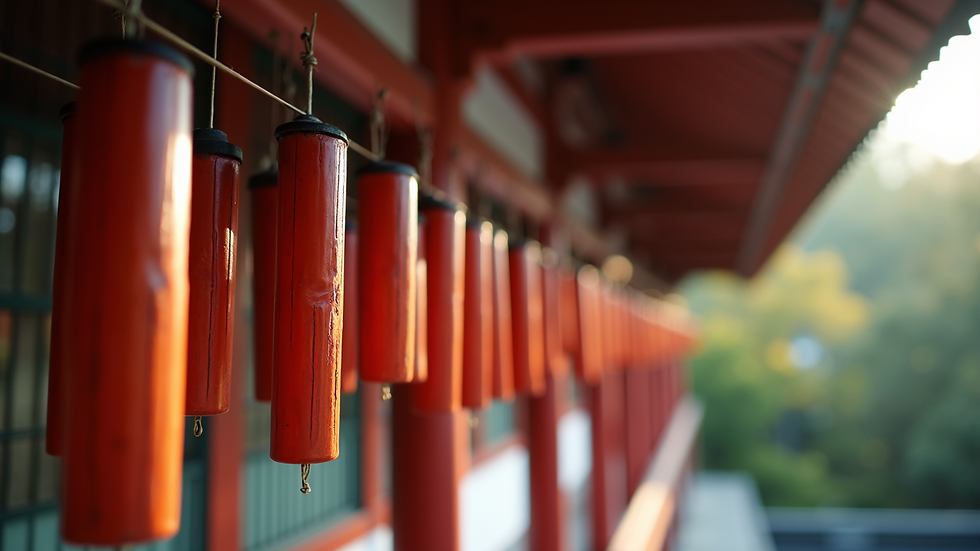Exploring Unique Craftsmanship in Wind Chimes
- foxbrae
- Jul 14
- 4 min read
Wind chimes have always held a fascination for many, enchanting us with their melodies and delicate designs. From tranquil backyards to bustling gardens, these delightful instruments serve not just as decor but as a means to connect with nature. In this blog post, we will explore the unique craftsmanship of wind chimes, diving into different materials, artistry, and the stories they tell.
Unique Craftsmanship
Wind chimes come in various forms, each reflecting the skills and artistic vision of their creators. The craftsmanship involved in making wind chimes is often intricate and meticulous, resulting in beautiful pieces that resonate with the unique sound of the materials used.
The Art of Material Selection
Successful wind chimes begin with thoughtful material selection. Some of the most popular materials include bamboo, metal, glass, and ceramic. Each serves its purpose in terms of sound, durability, and aesthetics.
Bamboo is a traditional material known for its warm, mellow tones. Bamboo chimes are lightweight and can easily sway in the gentlest breeze.
Metal wind chimes, made from aluminum, copper, or brass, are sturdy and provide a clear, crisp sound. They are often crafted through processes like hand-hammering, which not only gives them strength but also contributes to their unique tonal quality.
Glass and ceramic wind chimes deliver a more delicate sound and are often covered in vivid colors or intricate patterns. Craftspeople make these by layering and firing glass, allowing for endless custom designs.
When choosing a wind chime, consider how the material will fit into your outdoor space and personal style.

Cultural Significance
Wind chimes have rich cultural backgrounds across the globe. In various parts of Asia, particularly in Japan and China, wind chimes hold spiritual significance. They are often believed to ward off evil spirits and bring good fortune.
Japanese wind chimes, or “Fuurin,” are often made of glass and feature beautiful designs that change with the seasons. The sound of a Fuurin is considered soothing, and it marks the arrival of summer in Japan, where they hang in doors or windows.
Chinese wind chimes are commonly made from metal and often inscribed with symbols for happiness and luck. These pieces not only adorn homes but also play a role in traditional ceremonies and celebrations.
Embracing the cultural significance of wind chimes can enrich your experience, offering deeper meaning and appreciation for their beauty.

What is the most beautiful sounding wind chime?
Determining the most beautiful sounding wind chime is subjective, as it varies based on personal preference. However, many enthusiasts agree that the aluminum tube chimes tend to produce a sweet and melodious sound that resonates beautifully.
The craftsmanship behind these chimes typically involves precise tuning during manufacturing. Artisans meticulously cut the aluminum tubes to specific lengths to achieve distinct notes. When combined, they create harmonies that can uplift any outdoor space.
Some brands, such as fox-brae-windchimes, offer collections that prioritize not just aesthetic appeal but also acoustic excellence. Many users have shared how the soothing sounds can turn an ordinary backyard into a serene retreat.

Craft Techniques
The craft techniques vary widely among artisans, highlighting their unique skills. Here are a few worth mentioning:
Hand-tuning: Skilled artisans fine-tune each chime by hand, ensuring that the pitch aligns with their musical vision. This labor-intensive process results in chimes that produce harmonious sounds even in light winds.
Casting and shaping: Some metal wind chimes are created by casting, involving pouring melted metal into molds. This method allows for intricate designs, creating opportunities for artistic expression.
Inlaying techniques: Glass and ceramic chimes often employ inlay work, where different colored pieces are embedded into the design. This adds depth and uniqueness to every individual chime, making each piece a true work of art.
By understanding these techniques, you can appreciate the effort and precision put into each wind chime, making them more than just decorative items but also a testament to craftsmanship.
Caring for Your Wind Chimes
Once you invest in beautiful wind chimes, it's essential to care for them properly for lasting enjoyment. Here are a few tips:
Regular cleaning: Dust and debris can dampen the beauty of your wind chimes and affect their sound. Use a soft cloth and mild detergent to clean both the chimes and any decorative accents.
Storage considerations: If you live in an area with harsh winters, consider bringing your wind chimes indoors to protect them from extreme cold.
Position them wisely: Hang your wind chimes in a location where they can catch the wind but avoid areas with direct exposure to strong weather elements. This will prolong their life and maintain their tonal quality.
By taking these simple steps, you can ensure that your wind chimes continue to delight you with their beauty and sound for years to come.
Final Thoughts
Wind chimes are more than just decorative elements in your space; they are pieces of art that reflect the unique craftsmanship of skilled artisans. Whether you’re drawn to bamboo, metal, glass, or ceramic, each material offers a distinctive sound and aesthetic, infusing your environment with beauty and tranquility.
By caring for these artistic creations and understanding their relevance across cultures, you not only enrich your living space but also connect with a tradition that has resonated through time. So, find your perfect wind chime and let its melody be a reminder of the craftsmanship that has gone into its creation.





Comments